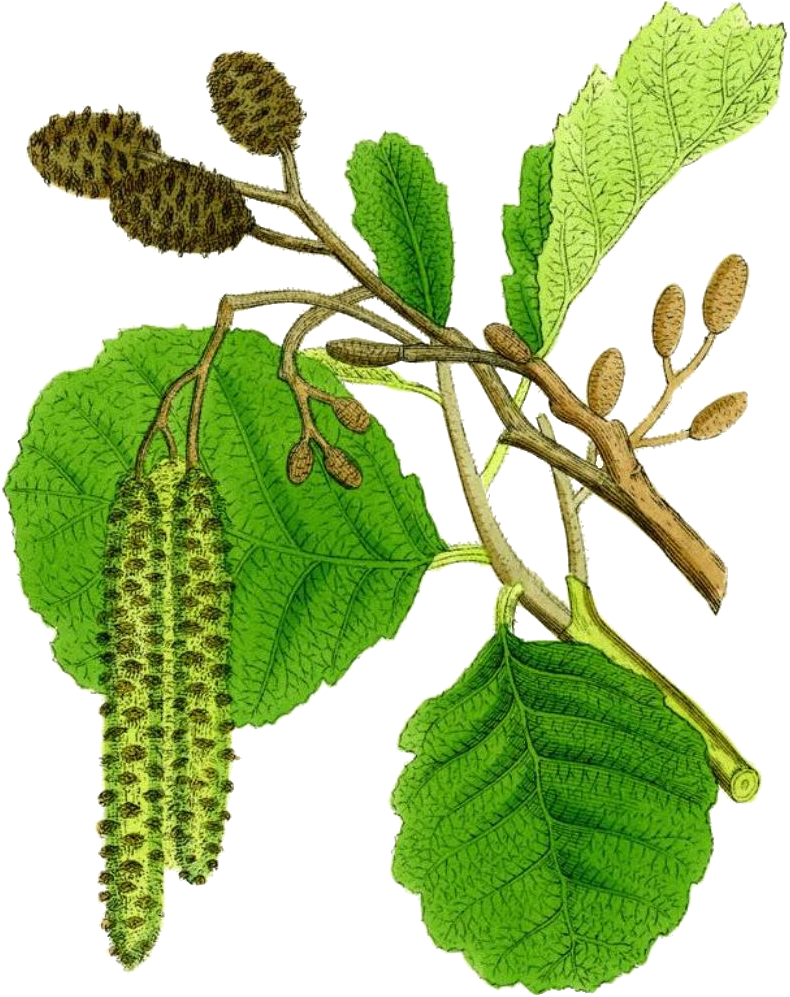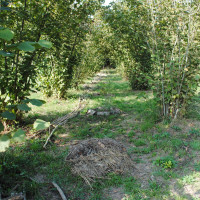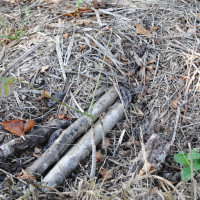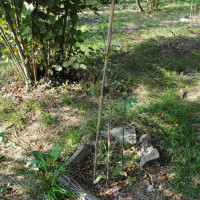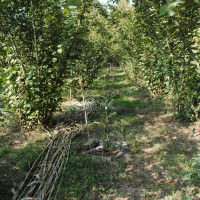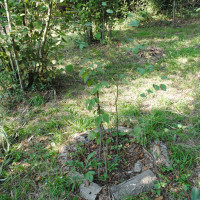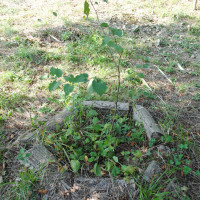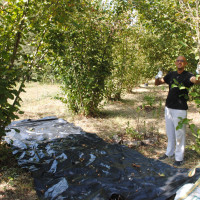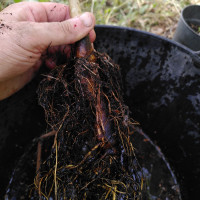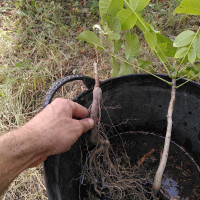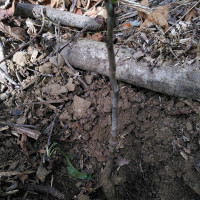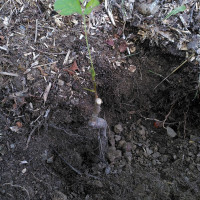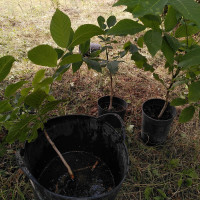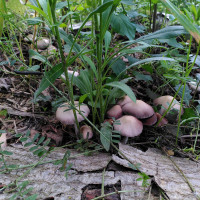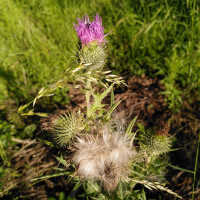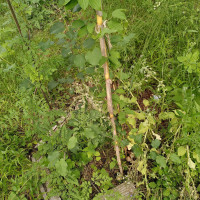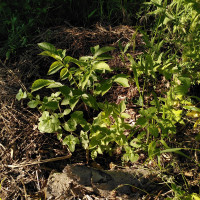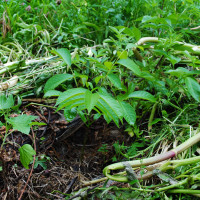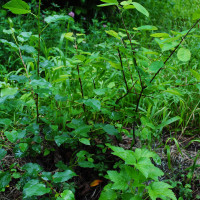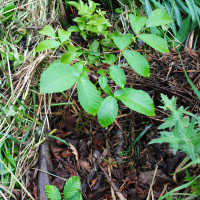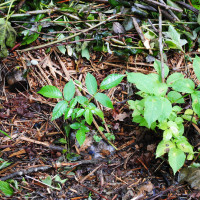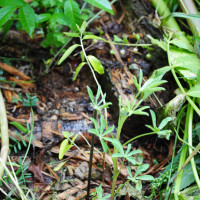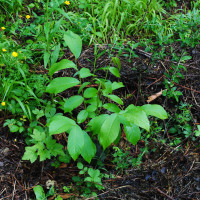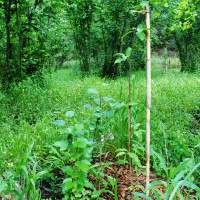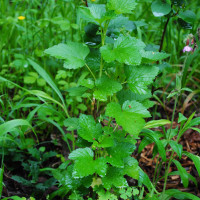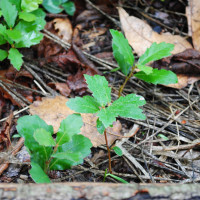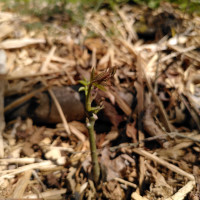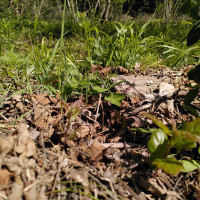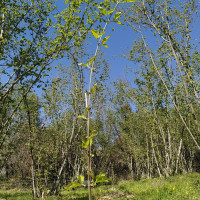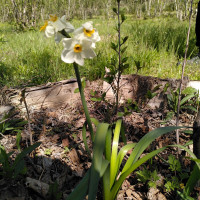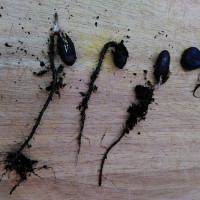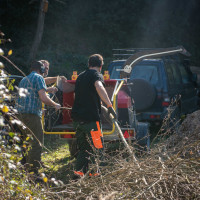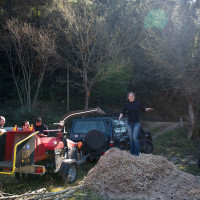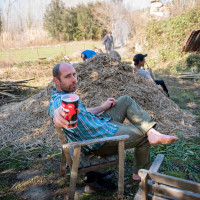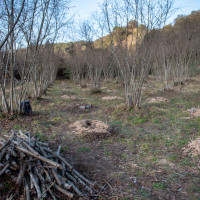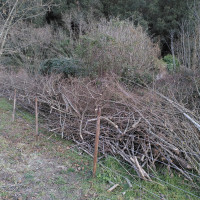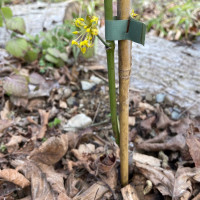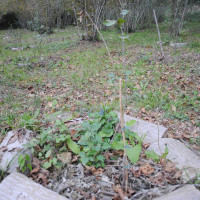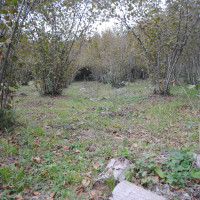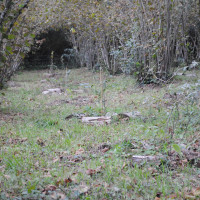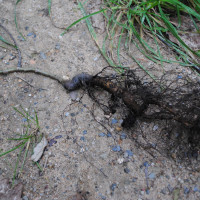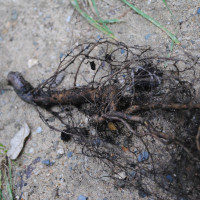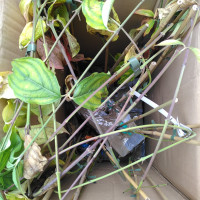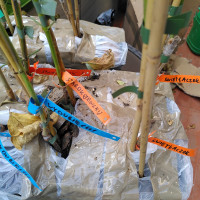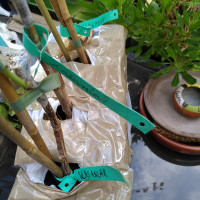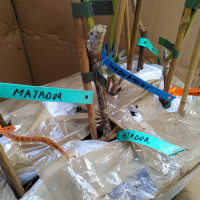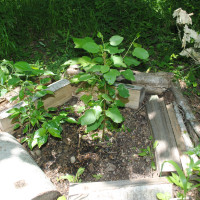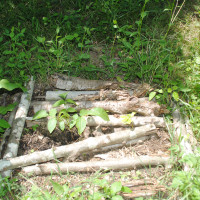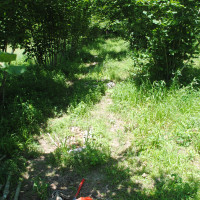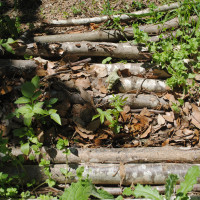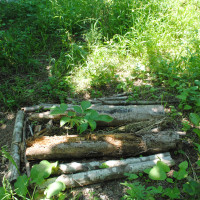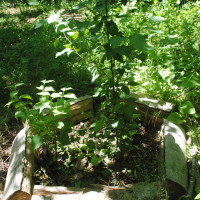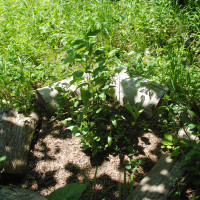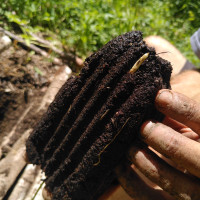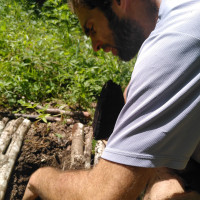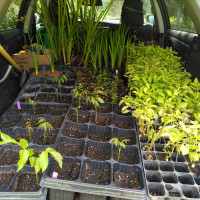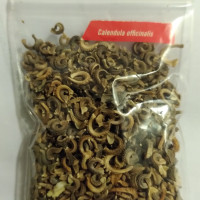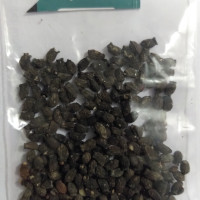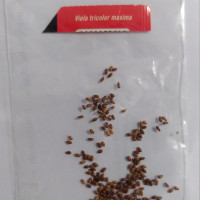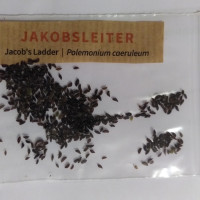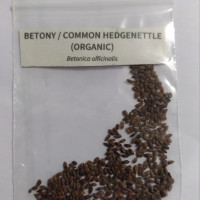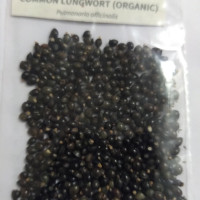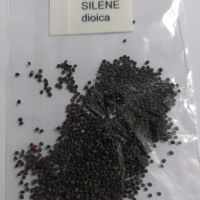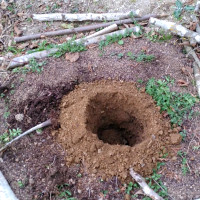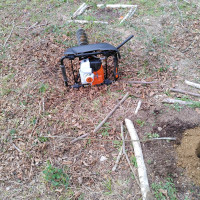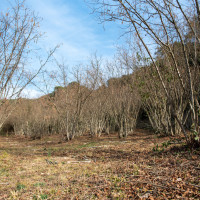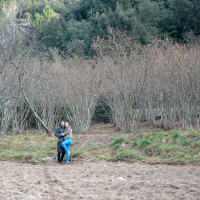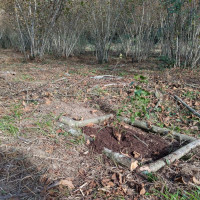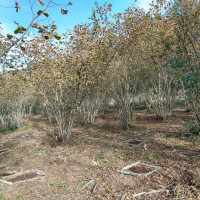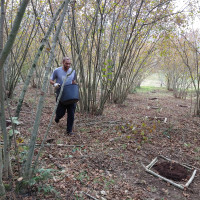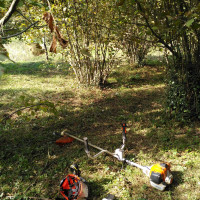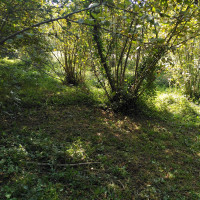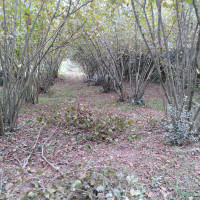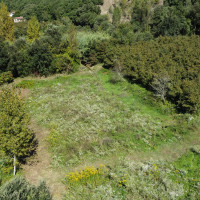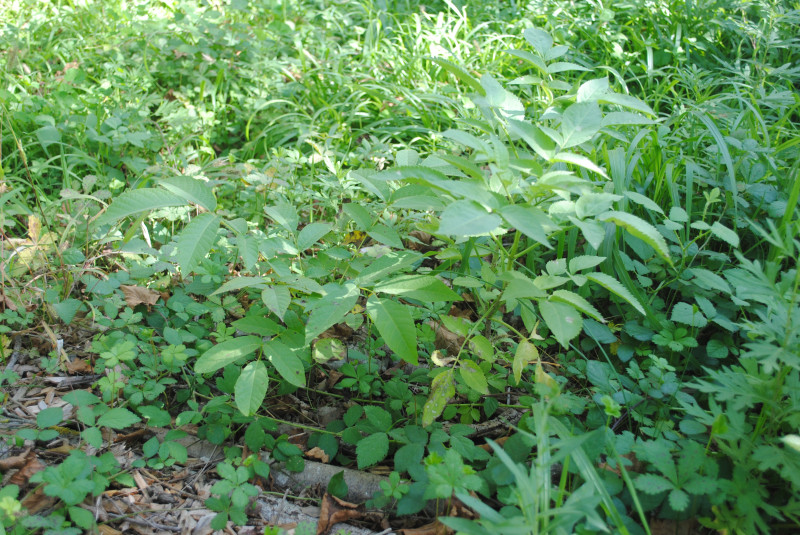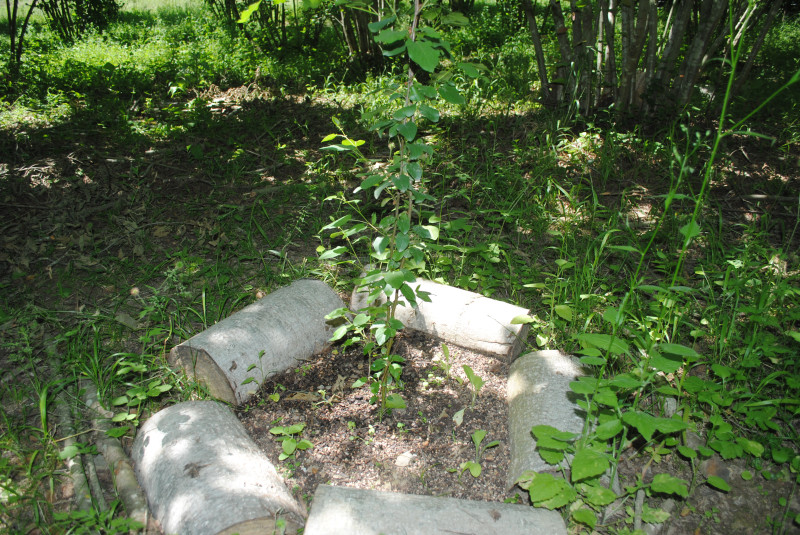Hazelnut mono → polyculture
Transition of a hazelnut-only field to a dense, multiple crop, self-fertilizing system.
Regional production of hazelnuts has decreased in recent years due to excess heat, even with irrigation. The objective of this transition is to cool down, provide partial shade to hazelnuts and grow alternative crop.
This plantation has no irrigation. Deep-rooted Oaks and Walnuts will theoretically assist in redistributing water in the soil. The accumulation of biomass and increase in vegetation density will help retain water.
The late leafing of the walnut allows species below to flower in the sun during early spring.
Hazelnut pruning will be minimal in the first year(s) to shade the ground. Once the walnuts establish, more light can come in for them grow above and form the new canopy.
C. avellana
| Species variety | Var | Leafing | Flowering | Fruiting | ||||||||||||||||||||||||||||||||||||
|---|---|---|---|---|---|---|---|---|---|---|---|---|---|---|---|---|---|---|---|---|---|---|---|---|---|---|---|---|---|---|---|---|---|---|---|---|---|---|---|---|
Corylus avellana Negreta de reus | Negreta de reus Fruto de calibre medio, de forma redonda un poco alargada. Carne blanca de buena calidad, también utilizada en la industria. Arbusto con poca altura y muy rústico, es una de las variedades más extendidas en España. Maduración en el mes de septiembre (Src:Arboreco) |
|
|
|
| Species variety | Tip | Qty | Introduction | Phase-out | Propagation | Medium | Supplier |
|---|---|---|---|---|---|---|---|
Corylus avellana Negreta de reus | Fruit trees in hot climate benefit from having a little bit of shade. [youtu.be] Hazelnut propagation best layered (not grafted). This allows to cut old, unproductive stems and have new suckers with the same genetic stock. [youtu.be] When pruning large branches, cut top half first to reduce weight. With less pressure cutting at the base, diagonally, becomes easier. [Can Neret] Manure + crop harvest can result in E. coli. This applies especially if harvesting crop on the ground, but hand harvesting also requires hygiene. | 77 | 2000-01-01 | Root division | Container |
| Species variety | Fnc | Strata | Top | Cut months | Light | Functions | |
|---|---|---|---|---|---|---|---|
Corylus avellana Negreta de reus | Canopy | 3.5m | Prune [2] | ~50% |
Cornus mas (group)
| Species variety | Var | Leafing | Flowering | Fruiting | ||||||||||||||||||||||||||||||||||||
|---|---|---|---|---|---|---|---|---|---|---|---|---|---|---|---|---|---|---|---|---|---|---|---|---|---|---|---|---|---|---|---|---|---|---|---|---|---|---|---|---|
Alnus cordata |
|
|
| |||||||||||||||||||||||||||||||||||||
Quercus pubescens |
|
|
| |||||||||||||||||||||||||||||||||||||
Cornus mas |
|
|
| |||||||||||||||||||||||||||||||||||||
Cornus mas Kasanlak | Kasanlak very big fruit, medium time of ripening, favourite for my wife! and some friends, pear shaped High-yielding Bulgarian Cornelian cherry with large pear-shaped fruits. Thrives on humus to clay soils and requires adequate water supply. The plant is fully frost-resistant and is also suitable for growing in the foothills up to an altitude of 1200 m. Vigour: upright, the plant has the character of a tree with a pyramidal crown. Older trees reach a height and width of approx. 4 m. With regular pruning, we keep the cornel cherry in a much smaller shape. Blossom: self-fertile Fruit: pear-shaped, bright red, average fruit weight 8 - 9 g, average fruit length 3.7 cm, rich in vitamin C Taste: sweet and sour, the fruits cannot be eaten immediately after picking , but it is necessary to wait a few days when they are fully ripe, softened and lose their sour taste Harvest season: second half of August Yield: high Usage: ripe fruits are ideal for making jams, compotes and for making homemade schnapps Disease resistance: generally good resistance to fungal diseases and pests |
|
|
| ||||||||||||||||||||||||||||||||||||
Cornus mas Matador | Matador A large-fruited French variety. Tasty, juicy fruits weighing 6.2-7.4 g. Late ripening at the turn of September and October. Very good for fresh consumption. |
|
|
| ||||||||||||||||||||||||||||||||||||
Cornus mas Starokijewski | Starokijewski Ukrainian variety ripening at the beginning of September. Ripe dark red fruit with a bottle shape with a narrow neck. Flesh red to dark red, juicy. Ripe tasty fruit, suitable for direct consumption as well as for preserves. The average fruit weight is 5.6-6 g (max 7.8 g). Seed mass 9.8-10.8% of the weight of the fruit. Yield from 15-year-old tree 35-40 kg and from 30-year-old up to 80 kg. The fruit does not fall after ripening. |
|
|
| ||||||||||||||||||||||||||||||||||||
Cornus mas Swietłaczok | Swietłaczok Ukrainian variety with large fruits (6.5-7.5 g), even up to 10 g in favorable conditions, in the shape of a bottle, red and black. Flesh dark red, thick, sweet and sour, very aromatic. Efficiency - up to 60 kg from a 15-year-old tree. The fruits ripen at the end of August, they do not spoil and are well suited for freezing and processing. The fruit contains 9.7% of sugars, organic acids - 1.6%. The dry matter content is about 22.7% of the weight of the fruit. The content of pectin 1%, vitamin C 150 mg%, anthocyanins in the parenchyma 102 mg% and in the skin 710 mg%. Seeds about 9% of the fruit weight. Fruits do not fall from the bushes, after storage you can store up to 4 weeks. Fully ripe fruits are very tasty. They are suitable for all kinds of preserves. |
|
|
| ||||||||||||||||||||||||||||||||||||
Cornus mas Wydubieckij | Wydubieckij Ukrainian large-fruited variety with an average fruit weight of 6.5-7.6 g. One of the longest varieties - the average yield from a dozen-year-old bush is about 50kg. Date of ripening: beginning of September. The fruit does not fall after ripening, it can be harvested once. Oval-pear fruit, dark-red color, shiny, juicy with sweet and sour pulp. The content of dry matter about 20% of the weight of the fruit. Sugars represent about 7.5%, acids about 1.6%, and pectin 1% by weight of the fruit. The content of vitamin C 157 mg%, anthocyanins in the parenchyma 98 mg% and in the skin 850 mg%. The fruits are tasty raw and suitable for processing into any processed products. |
|
|
| ||||||||||||||||||||||||||||||||||||
Ribes nigrum |
|
|
|
| Species variety | Tip | Qty | Introduction | Phase-out | Propagation | Medium | Supplier |
|---|---|---|---|---|---|---|---|
Alnus cordata | Alders increase the availability of soil phosphorus [researchgate.net] Alders are an important food plant for the caterpillars of many butterfly and moth species and also for small birds in winter.There are 90 insect species associated with this tree. [pfaf.org] "Nitrogen fixation requires rare heavy-metal element molybdenum as a catalyst." ... "To fix 1 gram of nitrogen, an estimated 10-100 grams of glucose is required.' Most microorganisms rarely have energy resources to produce large amounts of fixed nitrogen. Higher plants can produce excess energy through photosynthesis, but they cannot produce the necessary enzyme." [oregonstate.edu] | 30 | 2021-11-19 | Seed | Tray | Carex Vivers | |
Quercus pubescens | Comparing Quercus Pubescens, Q. Robur, Q. Petraea:
Semillas disponibles en Noviembre.
Tema de marcescencia (=hojas secas en los brotes hasta la nueva brotación): en Quercus robur las hojas son caducas, aunque en algunas localidades más cálidas dejan caer las hojas más tardíamente, en Quercus petraea se considera que las hojas son caducas con tendencia a la marcescencia, sobre todo en pies jóvenes y de brotes bajos, en Quercus pubescens las hojas son caducas con tendencia a la marcescencia, más patente en determinadas poblaciones, de los tres, es el que más presenta marcescencia en las regiones de Cataluña.
La caída/brotación de hoja: los ritmos vegetativos, (brotación floración, crecimiento y fructificación), aunque tienen una base genética, son también respuesta a los estímulos climáticos, y por lo tanto varían al igual que el ambiente a lo largo del territorio. Las tres especies son caducifolias, aunque la caída de hoja, un rasgo de adaptación a la parada invernal, es un carácter variable de acuerdo a la dureza del invierno en las distintas localidades. Así, La apertura de las yemas y crecimiento de los brotes nuevos se produce en abril-mayo, variando según la situación geográfica: para una misma estación climática, Quercus petraea es de 10 a 15 días más tardío que Quercus robur.
Rapidez de crecimiento: si bien el crecimiento de una especie forestal depende de factores fisiológicos, genéticos, de la calidad de estación y de los tratamientos, se puede establecer unos grupos de velocidad de crecimiento de distintas especies. Para las que comentas, pubescens parece mostrar mayor velocidad de crecimiento que petraea y robur, dado que también es la menor exigente de las tres. Robur sería, de las tres, el árbol que podría alcanzar mayor altura pero es más exigente en cuánto a la fertilidad del suelo.
Colonizador: pubescens es de los tres el de tendencia mayor a la colonización: es, de las tres, la más termófila, xerófila y heliófila de las tres.
Poda: en vivero las tres especies funcionan bien. [Plant supplier / nursery] | 30 | 2022-12-02 | Seed | Seed | Forestal Catalana | |
Cornus mas | Cornus Mas grafting: Svitlana Klymenko noted that the developed technology of vegetative reproduction allows to obtain high-quality planting material. Budding is the most efficient method for dogwood. Acceptance of meshes in nurseries is 90-95%, through lay-ups - 80-90%, and herbaceous cuttings - 75-78%. [Plant supplier / nursery] Low nitrogen demand. [Edible Forest Gardens Vol.2] I keep all cornus up to maximum 2 meters high. So they have stronger roots and small crone and than they have bigger fruit. [Plant supplier / nursery] | 15 | 2022-09-24 | Seed | Tray | Carex Vivers | |
Cornus mas Kasanlak | Cornus Mas grafting: Svitlana Klymenko noted that the developed technology of vegetative reproduction allows to obtain high-quality planting material. Budding is the most efficient method for dogwood. Acceptance of meshes in nurseries is 90-95%, through lay-ups - 80-90%, and herbaceous cuttings - 75-78%. [Plant supplier / nursery] Low nitrogen demand. [Edible Forest Gardens Vol.2] I keep all cornus up to maximum 2 meters high. So they have stronger roots and small crone and than they have bigger fruit. [Plant supplier / nursery] | 3 | 2022-11-15 | Graft | Container | Cornus Szkółka (PL) | |
Cornus mas Matador | Cornus Mas grafting: Svitlana Klymenko noted that the developed technology of vegetative reproduction allows to obtain high-quality planting material. Budding is the most efficient method for dogwood. Acceptance of meshes in nurseries is 90-95%, through lay-ups - 80-90%, and herbaceous cuttings - 75-78%. [Plant supplier / nursery] Low nitrogen demand. [Edible Forest Gardens Vol.2] I keep all cornus up to maximum 2 meters high. So they have stronger roots and small crone and than they have bigger fruit. [Plant supplier / nursery] | 3 | 2022-11-15 | Graft | Container | Cornus Szkółka (PL) | |
Cornus mas Starokijewski | Cornus Mas grafting: Svitlana Klymenko noted that the developed technology of vegetative reproduction allows to obtain high-quality planting material. Budding is the most efficient method for dogwood. Acceptance of meshes in nurseries is 90-95%, through lay-ups - 80-90%, and herbaceous cuttings - 75-78%. [Plant supplier / nursery] Low nitrogen demand. [Edible Forest Gardens Vol.2] I keep all cornus up to maximum 2 meters high. So they have stronger roots and small crone and than they have bigger fruit. [Plant supplier / nursery] | 3 | 2022-11-15 | Graft | Container | Cornus Szkółka (PL) | |
Cornus mas Swietłaczok | Cornus Mas grafting: Svitlana Klymenko noted that the developed technology of vegetative reproduction allows to obtain high-quality planting material. Budding is the most efficient method for dogwood. Acceptance of meshes in nurseries is 90-95%, through lay-ups - 80-90%, and herbaceous cuttings - 75-78%. [Plant supplier / nursery] Low nitrogen demand. [Edible Forest Gardens Vol.2] I keep all cornus up to maximum 2 meters high. So they have stronger roots and small crone and than they have bigger fruit. [Plant supplier / nursery] | 3 | 2022-11-15 | Graft | Container | Cornus Szkółka (PL) | |
Cornus mas Wydubieckij | Cornus Mas grafting: Svitlana Klymenko noted that the developed technology of vegetative reproduction allows to obtain high-quality planting material. Budding is the most efficient method for dogwood. Acceptance of meshes in nurseries is 90-95%, through lay-ups - 80-90%, and herbaceous cuttings - 75-78%. [Plant supplier / nursery] Low nitrogen demand. [Edible Forest Gardens Vol.2] I keep all cornus up to maximum 2 meters high. So they have stronger roots and small crone and than they have bigger fruit. [Plant supplier / nursery] | 3 | 2022-11-15 | Graft | Container | Cornus Szkółka (PL) | |
Ribes nigrum | Shrubs benefit from proximity for cross pollination. In shade: taller, thinner, leggier. In sun: denser, smaller [Edible Forest Gardens Vol.2] No grass near the roots. Shoots should not be older than 4 years for black currants, 5 years for other currants. Prune after harvesting. Need more than one variety for good pollination. Estacas de Ribes: Normalmente se entierra la mitad de la vara como máximo, 15- 20 cm. es suficiente en todo caso. Los primeros 20 cm. del suelo son los más fértiles normalmente. Lo que enraíza primero es la punta. Si se entierra demasiado es más probable que se infecte por patógenos. [Plant supplier / nursery] Ribes nigrum cuttings were collected November 9th. Planted on the 12th/nov. They had roots late December. [Can Neret] Cuttings directly on the ground need a wide area clearing and weed suppression, use large leaves and heavy thick mulch. [Can Neret] | 30 | 2022-02-08 | Seed | Tray | Forestal Catalana |
| Species variety | Fnc | Strata | Top | Cut months | Light | Functions | |
|---|---|---|---|---|---|---|---|
Alnus cordata | Emergent | 6m | Prune | Pioneering N | |||
Quercus pubescens | Possible succession to Alnus Cordata. 4-5 seeds each nest, already germinating | Canopy | 4m | Prune | Hydraulic lift, nutrient mining | ||
Cornus mas | Understory | 3m | Prune | ~50% | Rootstock for grafting | ||
Cornus mas Kasanlak | Understory | 3m | Prune | ~50% | |||
Cornus mas Matador | Understory | 3m | Prune | ~50% | |||
Cornus mas Starokijewski | Understory | 3m | Prune | ~50% | |||
Cornus mas Swietłaczok | Understory | 3m | Prune | ~50% | |||
Cornus mas Wydubieckij | Understory | 3m | Prune | ~50% | |||
Ribes nigrum | Grown from wild seeds. Options for new varieties. Wild currants may perform better in the shade than selected cultivars. | Understory | 1.5m | Prune | ~50% |
Juglans regia (group)
| Species variety | Var | Leafing | Flowering | Fruiting | ||||||||||||||||||||||||||||||||||||
|---|---|---|---|---|---|---|---|---|---|---|---|---|---|---|---|---|---|---|---|---|---|---|---|---|---|---|---|---|---|---|---|---|---|---|---|---|---|---|---|---|
Juglans regia |
|
|
| |||||||||||||||||||||||||||||||||||||
Elaeagnus angustifolia |
|
|
| |||||||||||||||||||||||||||||||||||||
Ribes nigrum Andega | Andega variedade francesa caracterizada pola súa resistencia a enfermidades, sobre todo a oidio. Froito negro en acios e moi productiva. (Src:Fragaira) |
|
|
| ||||||||||||||||||||||||||||||||||||
Ribes nigrum Ben more | Ben more floración tardía.Fructifica de mediados a final de temporada. Froito grande, de cor negro, planta de porte erguido. (Src:Fragaira) |
|
|
| ||||||||||||||||||||||||||||||||||||
Sambucus nigra |
|
|
|
| Species variety | Tip | Qty | Introduction | Phase-out | Propagation | Medium | Supplier |
|---|---|---|---|---|---|---|---|
Juglans regia | Interplanting walnut plantations with a nitrogen fixing plant, such as Elaeagnus × ebbingei or Elaeagnus umbellata, and various Alnus species, results in a 30% increase in tree height and girth (Hemery 2001). [Hemery 2001] Walnuts characteristics for Agroforestry: late leafing, early leaf fall, and 50% shade. Deep roots cycle nutrients. [utl.pt] Any pruning should only be carried out in late summer to early autumn or when the plant is fully dormant otherwise wounds will bleed profusely and this will severely weaken the tree. [pfaf.org] Trees grown from seed (pre-germination recommended) are more liikely to survive non-irrigated plantations, as they form a deeper root system and better ratio between aerial and root volumes. At large scale this reduces costs and risk. [youtu.be] Manure + crop harvest can result in E. coli. This applies especially if harvesting crop on the ground, but hand harvesting also requires hygiene. | 30 | 2022-04-29 | Seed | Tray | Viver Tres Turons | |
Elaeagnus angustifolia | Propagates cultivars by cuttings. [Plant supplier / nursery] | 10 | 2023-04-12 | Seed | Tray | Wild | |
Ribes nigrum Andega | Shrubs benefit from proximity for cross pollination. In shade: taller, thinner, leggier. In sun: denser, smaller [Edible Forest Gardens Vol.2] No grass near the roots. Shoots should not be older than 4 years for black currants, 5 years for other currants. Prune after harvesting. Need more than one variety for good pollination. Estacas de Ribes: Normalmente se entierra la mitad de la vara como máximo, 15- 20 cm. es suficiente en todo caso. Los primeros 20 cm. del suelo son los más fértiles normalmente. Lo que enraíza primero es la punta. Si se entierra demasiado es más probable que se infecte por patógenos. [Plant supplier / nursery] Ribes nigrum cuttings were collected November 9th. Planted on the 12th/nov. They had roots late December. [Can Neret] Cuttings directly on the ground need a wide area clearing and weed suppression, use large leaves and heavy thick mulch. [Can Neret] | 15 | 2023-02-19 | Stem cutting | Cutting | Fragaira | |
Ribes nigrum Ben more | Shrubs benefit from proximity for cross pollination. In shade: taller, thinner, leggier. In sun: denser, smaller [Edible Forest Gardens Vol.2] No grass near the roots. Shoots should not be older than 4 years for black currants, 5 years for other currants. Prune after harvesting. Need more than one variety for good pollination. Estacas de Ribes: Normalmente se entierra la mitad de la vara como máximo, 15- 20 cm. es suficiente en todo caso. Los primeros 20 cm. del suelo son los más fértiles normalmente. Lo que enraíza primero es la punta. Si se entierra demasiado es más probable que se infecte por patógenos. [Plant supplier / nursery] Ribes nigrum cuttings were collected November 9th. Planted on the 12th/nov. They had roots late December. [Can Neret] Cuttings directly on the ground need a wide area clearing and weed suppression, use large leaves and heavy thick mulch. [Can Neret] | 15 | 2023-02-19 | Stem cutting | Cutting | Fragaira | |
Sambucus nigra | Elderberry cuttings take months to root. Had more success with propagation at end of summer, after the first rains wet the ground and the parent plant are hydrated. [Can Neret] | 15 | 2022-05-07 | Seed | Tray | Forestal Catalana |
| Species variety | Fnc | Strata | Top | Cut months | Light | Functions | |
|---|---|---|---|---|---|---|---|
Juglans regia | Recently germinated to keep taproot untouched. Germination of all 30 walnuts spanned a period of one month. Planting was done gradually. | Emergent | 8m | ~50% | Hydraulic lift, nutrient mining, Crop shading | ||
Elaeagnus angustifolia | Pioneering until shadded, will be replaced with cuttings of E. multiflora | Understory | 7m | Prune [6] | Pioneering N | ||
Ribes nigrum Andega | Understory | 1.5m | Prune | ~50% | |||
Ribes nigrum Ben more | Understory | 1.5m | Prune | ~50% | |||
Sambucus nigra | Understory | 2m | Prune | ~50% | Pioneering |
Project Log
2023 week 40 28/14°C, 0.1mm
2023 week 39 30/13°C, 0mm
2023 week 38 27/14°C, 6.7mm
2023 week 37 30/16°C, 36.8mm
2023 week 36 32/13°C, 0mm
Moved canes (Arundo donax?) from canal entry as biomass.
2023 week 36 33/15°C, 0mm
2023 week 35 28/14°C, 0.8mm
2023 week 34 36/20°C, 26.8mm
2023 week 33 36/17°C, 0mm
2023 week 32 33/18°C, 0.5mm
Harvesting hazelnuts, a little late. Most nuts were already on the ground. Possible early drop due to drought and heat stress.
2023 week 36 33/14°C, 0mm
2023 week 35 28/14°C, 0.8mm
2023 week 34 36/20°C, 26.8mm
2023 week 33 36/17°C, 0mm
2023 week 32 33/18°C, 0.5mm
All 5 walnuts on the first west-side row (more exposed) did not survive. Root structure from nursery plant vs uprooted 2-season plant.
2023 week 23 28/14°C, 4.2mm
2023 week 22 26/12°C, 17.8mm
2023 week 21 26/12°C, 46mm
2023 week 20 23/8°C, 6.4mm
2023 week 19 23/10°C, 63.1mm
Funghi, and flowering thistle.
2023 week 19 23/11°C, 55mm
2023 week 18 26/9°C, 16.1mm
2023 week 17 25/11°C, 10.2mm
2023 week 16 23/6°C, 6.8mm
2023 week 15 22/5°C, 0.9mm
Mulch from clearing the ruins and canals added to walnut nests. Alnus cordata (alternate nests) are untouched to retain diversity.
2023 week 14 20/2°C, 0mm
2023 week 13 21/5°C, 3.6mm
2023 week 12 21/6°C, 0mm
2023 week 11 20/5°C, 8.1mm
2023 week 10 22/5°C, 0mm
Walnut leafing, oak emerges from ground, Cornus mas in full leaf.
2023 week 10 21/4°C, 0mm
2023 week 09 14/-0°C, 0.4mm
2023 week 08 16/4°C, 27.5mm
2023 week 07 18/-0°C, 0.2mm
2023 week 06 11/0°C, 43.4mm
Quercus pubescens root development in container between November and March (left). Chestnut (right).
2023 week 07 17/-1°C, 0.2mm
2023 week 06 11/0°C, 43.4mm
2023 week 05 19/-2°C, 0mm
2023 week 04 10/-4°C, 3.1mm
2023 week 03 12/-1°C, 0.1mm
Shredding hazelnut branches during calçotada
2023 week 05 19/-2°C, 0mm
2023 week 04 10/-4°C, 3.1mm
2023 week 03 12/-1°C, 0.1mm
2023 week 02 17/2°C, 8.4mm
2023 week 01 17/3°C, 0.1mm
Pruned hazelnuts to shred
2023 week 04 10/-4°C, 3.1mm
2023 week 03 12/-1°C, 0.1mm
2023 week 02 17/2°C, 8.4mm
2023 week 01 17/3°C, 0.1mm
2023 week 52 18/2°C, 0mm
Cornus mas flowering
2022 week 47 15/5°C, 13.4mm
2022 week 46 19/8°C, 13.9mm
2022 week 45 23/8°C, 2.2mm
2022 week 44 23/7°C, 2mm
2022 week 43 26/10°C, 0.1mm
Cornus mas, planted 2022-11-15, and overview
2022 week 47 15/5°C, 13.4mm
2022 week 46 19/8°C, 13.9mm
2022 week 45 23/8°C, 2.2mm
2022 week 44 23/7°C, 2mm
2022 week 43 26/10°C, 0.1mm
Root system of backup walnuts that were kept in containers during the summer
2022 week 46 23/9°C, 0mm
2022 week 45 23/8°C, 2.2mm
2022 week 44 23/7°C, 2mm
2022 week 43 26/10°C, 0.1mm
2022 week 42 27/13°C, 0.1mm
Cornus Mas grafted trees arrived. Excellent packaging.
2022 week 22 28/12°C, 0mm
2022 week 21 27/13°C, 15.5mm
2022 week 20 32/12°C, 0.1mm
2022 week 19 28/11°C, 27mm
2022 week 18 24/10°C, 6.2mm
Juglans regia and Alnus cordata growing slowly in part-shade, but protected from the summer heat and drought.
2022 week 20 31/12°C, 0.1mm
2022 week 19 28/11°C, 27mm
2022 week 18 24/10°C, 6.2mm
2022 week 17 23/8°C, 13mm
2022 week 16 19/8°C, 47.8mm
Walnut taproot and careful planting.
2022 week 17 24/7°C, 0.1mm
2022 week 16 19/8°C, 47.8mm
2022 week 15 21/8°C, 5.6mm
2022 week 14 20/4°C, 12.6mm
2022 week 13 15/4°C, 24.4mm
Walnut planting throughout May while germinations took place, to allow the taproot to develop undisturbed.
2022 week 13 21/6°C, 0mm
2022 week 12 16/5°C, 15.2mm
2022 week 11 14/9°C, 34.7mm
2022 week 10 14/5°C, 64.1mm
2022 week 09 16/4°C, 9.3mm
Seeded shade tolerante flowers on Alnus cordata nests
2022 week 08 18/2°C, 0mm
2022 week 07 18/2°C, 3.1mm
2022 week 06 17/1°C, 0.1mm
2022 week 05 17/1°C, 0mm
2022 week 04 18/-2°C, 0.1mm
Drilling holes to ensure walnut seedlings can grow deep roots.
2022 week 05 18/0°C, 0mm
2022 week 04 18/-2°C, 0.1mm
2022 week 03 14/-2°C, 0.1mm
2022 week 02 14/-2°C, 1.4mm
2022 week 01 15/-0°C, 2.9mm
During calcotada
2021 week 46 17/4°C, 1.3mm
2021 week 45 18/7°C, 31.4mm
2021 week 44 18/3°C, 5.9mm
2021 week 43 22/8°C, 0.4mm
2021 week 42 24/9°C, 0.1mm
Compost distribution
2021 week 43 22/7°C, 0.1mm
2021 week 42 24/9°C, 0.1mm
2021 week 41 23/7°C, 0.1mm
2021 week 40 23/10°C, 16.4mm
2021 week 39 27/13°C, 0mm
Ground clearing. Ivy and bramble removal
Lessons
-
[Design] Fruit trees in hot climate benefit from having a little bit of shade.(Corylus avellana ,Prunus avium ,Prunus cerasifera ,Prunus persica) - Hemery 2001
[Design] Interplanting walnut plantations with a nitrogen fixing plant, such as Elaeagnus × ebbingei or Elaeagnus umbellata, and various Alnus species, results in a 30% increase in tree height and girth (Hemery 2001).(Juglans regia) -
[Design] No grass near the roots. Shoots should not be older than 4 years for black currants, 5 years for other currants. Prune after harvesting. Need more than one variety for good pollination.(Ribes nigrum ,Ribes rubrum) -
[Design] Walnuts characteristics for Agroforestry: late leafing, early leaf fall, and 50% shade. Deep roots cycle nutrients.(Juglans regia) - Cornus Mas grafting: Svitlana Klymenko noted that the developed technology of vegetative reproduction allows to obtain high-quality planting material. Budding is the most efficient method for dogwood. Acceptance of meshes in nurseries is 90-95%, through lay-ups - 80-90%, and herbaceous cuttings - 75-78%.Plant supplier / nursery
(Cornus mas) - Can Neret
[Prune] When pruning large branches, cut top half first to reduce weight. With less pressure cutting at the base, diagonally, becomes easier.(Corylus avellana) -
[Design] "Nitrogen fixation requires rare heavy-metal element molybdenum as a catalyst." ... "To fix 1 gram of nitrogen, an estimated 10-100 grams of glucose is required.' Most microorganisms rarely have energy resources to produce large amounts of fixed nitrogen. Higher plants can produce excess energy through photosynthesis, but they cannot produce the necessary enzyme."(Alnus cordata ,Alnus glutinosa) - I keep all cornus up to maximum 2 meters high. So they have stronger roots and small crone and than they have bigger fruit.Plant supplier / nursery
(Cornus mas)
